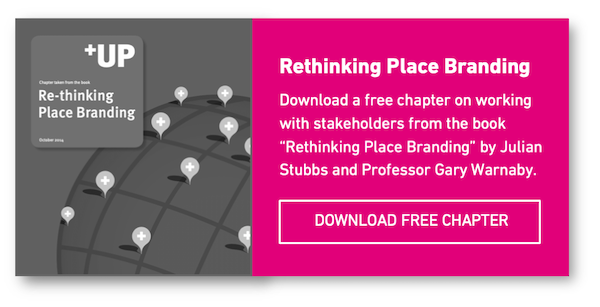In some circles, place branding is seen as the inevitable evolution of place marketing (or destination marketing) and a prerequisite for successful tourism, export or investment promotion. But is place branding an essential undertaking for an international (or regional place) or secondary to marketing efforts?
Branding represents the process of using planned communication to influence how a target audience perceives a specific product or service. Place branding is a similar process employed at the country, city or destination level. Marketing, on the other hand, typically has a more specific or short-term goal (deliver leads, create website traffic, get responses to advertising) and is focused on tactical approaches. In other words, marketing focuses on getting people to notice you, whereas branding focuses on what they think (or say) about you. Branding is the work behind the marketing.
Place branding plays an important role in attracting foreign direct investment (FDI), boosting businesses and drawing tourists and talent. It is the bridge between public diplomacy and economic benefits. An adequate policy of place branding – based on a positive, credible and economically reliable image – can extend the range of potential FDI.
Place branding delivers long-term benefits
Activities such as tourism, exported brands and government policies can work in favor of a place brand (or against it). An area’s reputation (including topics such as diversity and inclusivity), cultural heritage and other elements can help magnify or polish a country or city’s brand and its ability to attract investment and talent. Place branding helps turn a collection of ideas or impressions about a city, region or destination into a cohesive brand that attracts additional investment, business and people. Yet, place branding is only possible with the cooperation of leadership, the private sector and the local population.
A place’s international reputation can be enhanced, polished and managed as long as there is a clear strategy for it that has buy-in and good coordination between government, the public and private sector, and the population in general.
The branding of elements within a region can also contribute to the region’s overall place brand. This includes areas such as tourist and financial districts, museums, shopping malls, bazaars and food districts, which collectively add to the wider image of the country or city. Consider how the areas of Mayfair or Kennsington add to London’s place brand, or SOHO or the West Village contribute to New York’s brand image. Even when a country does not deliberately manage its name as a brand, people retain images of countries that can be activated simply by a name (Kotler and Gertner, 2002).
The results of place branding (including elements such as logos, signs and billboards) may be highly visible, but the visible part is only a small piece of the overall work that happens to reach that point. A lot of time and effort goes into gathering stakeholders, finding consensus and aligning their vision. Involving all stakeholders at an early stage and with careful management is critical for successful place branding. A place brand must have a long-term focus – it’s an alignment of visions that should be very long-lasting. For example, the place branding work for Stockholm, “the Capital of Scandinavia” has been in use for more than 17 years now.
 The classic and simple I heart NY tagline still remains significant and has been copied by many places as an example of place branding. However, things in place branding have changed a lot since the ‘70s when this slogan first appeared. These days the focus in place branding has shifted away from this one size fits all approach. A place is, after all, more than a logo.
The classic and simple I heart NY tagline still remains significant and has been copied by many places as an example of place branding. However, things in place branding have changed a lot since the ‘70s when this slogan first appeared. These days the focus in place branding has shifted away from this one size fits all approach. A place is, after all, more than a logo.
The focus now is on community engagement and local pride, economic development and growth that attracts external audiences via a compelling story of local life. Telling a consistent, distinct and authentic story is important.
Which comes first, branding or marketing?
For many place marketers, the idea of developing and polishing an underlying place brand is considered essential to marketing efforts.
‘… there is no question that the concept of brand is relevant and useful to places, both at the sectoral level and in their roles as “umbrella brands” providing reassurance, glamour or status to the products and services that are marketed under their aegis. A positive place image, in short, makes it cheaper and easier for producers to export and attract’.
(Govers, 2011)
In short, developing a favorable place brand makes it easier for all the brands it represents to be successful. But which comes first, the positive image or the success of brands that it “exports”? It might be worth considering some examples to explore the idea.
Consider Dubai. The city can be counted as a very successful example of place branding. In addition to the huge number of expats living there, which proves the attractiveness of the city’s lifestyle, Dubai has received worldwide recognition for its ambitious architectural projects, such as an underwater hotel, the Palm Islands, and the tallest building in the world, Burj Khalifa, which support its brand of luxury real estate and tourism.
The worldwide recognition is not confined to tourism, but also inclusive of efforts to become a leading smart city, while maintaining its Middle Eastern nuances from a cultural point of view. The branding strategy demands an approach in which Dubai is connected to the latest technology, creating a commercial and transportation hub that enjoys a cosmopolitan background, making it possible to attract potential investors and quality inhabitants from around the world. And even recently, by easing the requirements for obtaining long-term visas, passports and retiring in the UAE.
The Gulf Cooperation Council (GCC), the political and economic union of Arab states bordering the Gulf region, has a very ambitious and rapid economic growth agenda that requires employing a bold – and for some countries – totally different branding strategy. The leadership and the people want to project a high income, wealthy image for the region’s cities and countries.
To succeed, they need to communicate and convey a series of consistent messages to the outside world. Now, with several of the gulf region’s countries like Saudi Arabia having goals that include attracting tourists and FDI as part of their 2030 vision, a strong place branding effort is vital to the plan. For Middle East countries to realize their vision, place branding becomes an essential element of future success, not an extraneous undertaking.
Case study: Developing a new logotype for the Netherlands Embassy in UAE
What are the essential next steps?
Creating a positive place brand not only helps draw in businesses and international residents, but also further reinforces the ability to market the area.
Creating a successful place brand means embracing an approach that brings together all the stakeholders and can be accepted. Here are some essential elements of effective place branding.
- Authentic. Place branding needs to ring true not only for those who are stakeholders in the brand (the businesses, internal investors, leaders) but also for those visiting or relocating (tourists or transplants/expats).
- Unique. Your brand positioning should not only be authentic, but also unique. You can’t create a sense of place for your brand if it sounds the same as all your neighbors, or worse, you’re trying to be the “Venice of XYZ region.” Comparing yourself to another place doesn’t create a unique brand.
- Memorable. In order to be memorable, your brand needs to engender a feeling or tell a story. People remember how they felt or the stories they associate with your place.
- Inclusive. In order to be successful, your place brand needs to resonate with all stakeholders, include them in its creation, and be real to them. Businesses and leaders must adopt the framework of your branding to be successful.
- Intertwined. The place brand needs to be interwoven into all aspects of the region’s identity: recognizing common objectives and points of interest among stakeholders. To uphold your brand’s promise, adoption is essential.
Read more: Three elements of great place branding
Want to know more about place branding? Contact us


